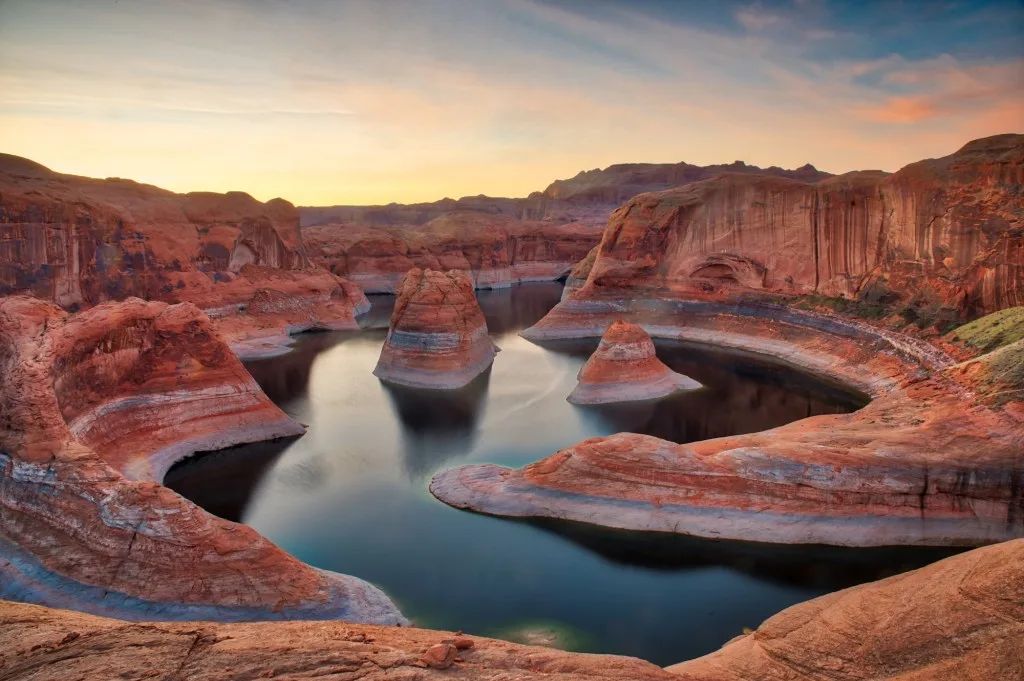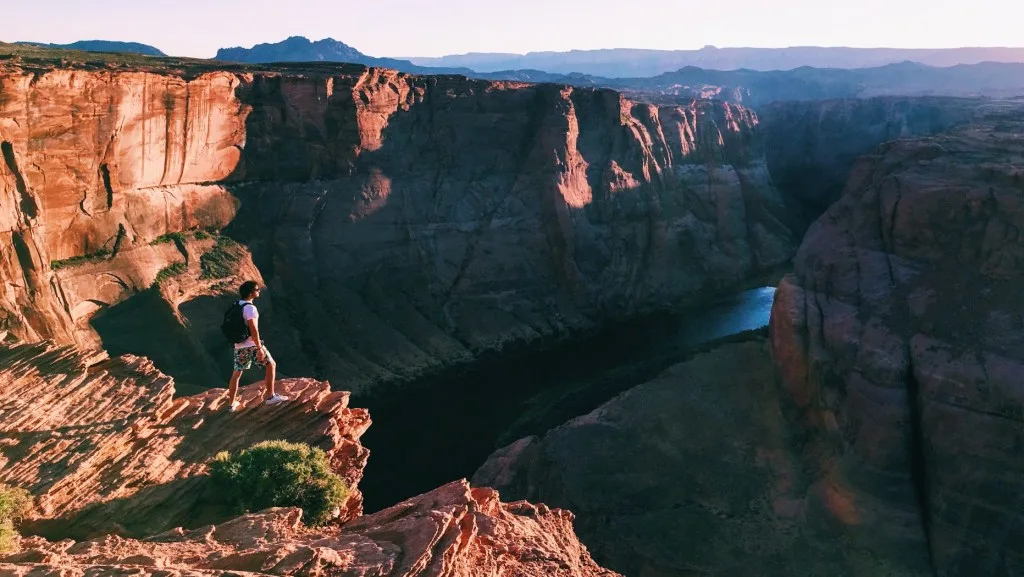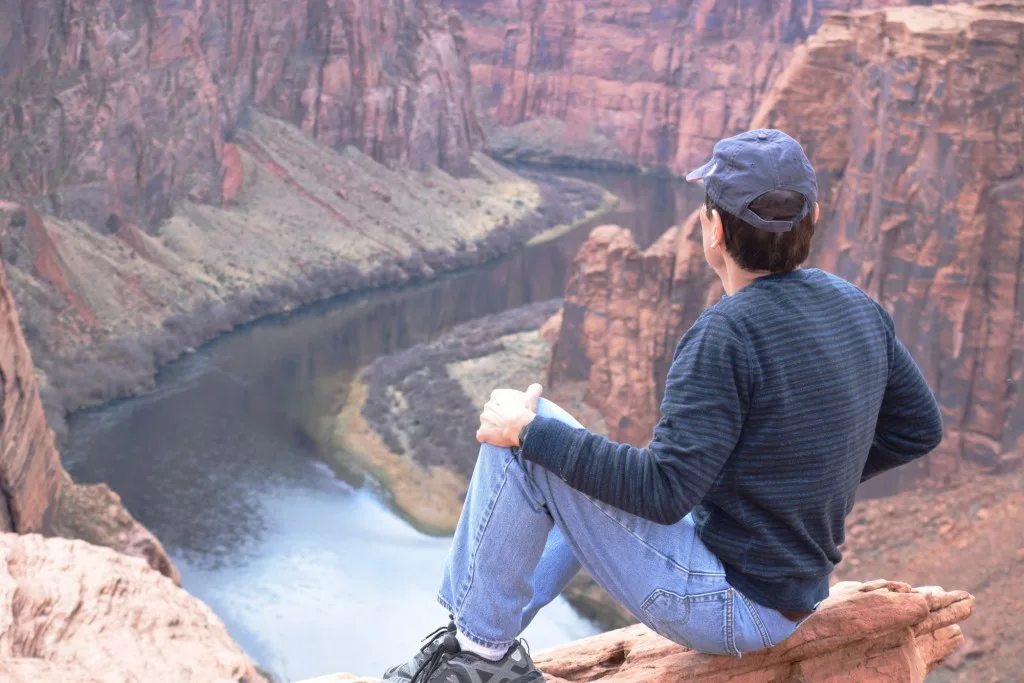Do you picture the Mighty Mississippi River or the Missouri River when you think of U.S. rivers? But the Colorado River is a body of water that desperately deserves our attention.
This massive river is an important water source for millions of people in many states and Mexico.
And it’s on the verge of drying up over the next few years. We must educate ourselves about this pivotal water source in hopes that we can help revitalize it.
What Is the Colorado River?
The Colorado River has run through canyons, mountains, plains, and deserts for six million years. It brings water to 36 million people through heat and cold, seven states, two countries, and nine national parks. The Colorado River may not be the biggest or the longest, but it is one of the country’s most needed bodies of water.
Its headwaters start in the Rocky Mountains, which flow mostly southwest across the Colorado Plateau and through the Grand Canyon. It then reaches Lake Mead on the Arizona-Nevada border, turning abruptly south toward Mexico.
Much of the length of the Colorado River has major dams that significantly constrain its flow. It is one of only a few rivers in North America with enough water to support such widespread human use — or at least it used to have enough water.
It has two very different basins. The Upper Colorado River Basin has a series of rivers above Lee’s Ferry in northern Arizona. This area includes Colorado, New Mexico, Wyoming, and Utah. Winter snowpack and spring snowmelt from this region are major water sources for the entire basin.
The Lower Colorado River, below Lake Powell, runs through Nevada, Arizona, California, and ultimately into Mexico, where it used to drain into the Sea of Cortez. It has become so overused that it no longer flows to the sea.
The two basins have different climates and ecosystems, supporting different plant and animal life. Millions rely on this majestic river for drinking water, hydroelectric power, agricultural needs, recreational usage, and more.
Pro Tip: Heading to Colorado? Head out for a hike on one of these 11 Best Trails for Hiking in Colorado.

Is the Colorado River in a Drought?
The Colorado River is one of the most important rivers in North America, and it’s in trouble. Due to climate change and overuse, it is facing a severe drought.
Because it supplies water to millions of people across the southwest, this has led to conflicts among the states that share this vital resource. Not only does this impact the people, but it also puts an immense strain on the river’s ecosystem. So what’s causing the river to dry up?
What Is Causing the Colorado River to Dry Up?
Decades of wasteful water management policies and practices have led to a situation where the demand for the river’s water now exceeds its supply. Storage levels at Lake Powell and Lake Mead, two of the Colorado River’s major reservoirs, are exceedingly low.
The Lower Colorado River is currently facing a one million acre-foot deficit. It runs dry before reaching its natural delta in the Gulf of California.
The seven states that share the river designed the Colorado River Compact in 1922 to protect the water and ensure fair use among the states. However, it has seen decades of wasteful water management and overuse, river flow fluctuations, and climate change. The Colorado River Water Compact no longer works to conserve the water as it once did.
How Long Until the Colorado River Dries Up?
Now, we must ask ourselves how long until the Colorado River dries up. According to American Rivers, the Colorado River will have a 10-30% flow reduction by 2050 due to climate change. This impacts the snowmelt that supplies most of the Colorado River with its water.
Water availability has trended downward since 2000 due to climate change. But it’s more than that. The population growth and excessive agricultural use have depleted it more.
The Upper Basin struggles with climate change which increases drought. And the Lower Basin uses 1.2 million more acre-feet of water than flows down from the Upper Basin. So, it’s likely that this mighty river could completely dry up within the next few decades.

Will the Colorado River Recover?
The Colorado River is in danger of drying up. However, the Colorado River can recover with a commitment to water sustainability management programs and agreements between governmental and personal entities.
But there is no simple solution. The Colorado River is a complex system, and any potential solutions must address various environmental and social factors. Nevertheless, we can take steps to help the river recover.
First, municipalities can expand water conservation efforts through improved landscaping and water-saving appliances. Second, irrigation scheduling and water banking can improve agricultural efficiency.
Third, we can increase renewable energy through wind, solar, and geothermal power. Finally, we can pursue innovative water-saving opportunities. These include ridding the shoreline of invasive plants and lessening the dust on snow as this increases evaporation.
By taking these steps and others, we can help the Colorado River recover. We can ensure that it continues to provide vital resources for the Western United States and Mexico.
What Is the Deepest Part of the Colorado River?
The Colorado River is one of the most iconic rivers in the United States. It runs through some of the most breathtaking scenery in the country. Its waters form a vital source of life for countless plants, animals, and humans. But just how deep is the Colorado River?
In its 1,450 miles, the Colorado River averages about 20 feet deep. However, its deepest point is around 80 feet as it flows through parts of the Grand Canyon.
Pro Tip: Exploring Colorado? Spend the night at one of these 11 Totally Free Camping Spots in Colorado.

How Can We Save the Colorado River?
Because of its importance for millions within two countries, we must work together to save the Colorado River. Decades of drought and overuse have taken their toll. Once a mighty river that carved out the Grand Canyon is now so depleted that it often fails to reach the Sea of Cortez. And scientists warn that it could run dry within our lifetime.
Luckily, we can save the Colorado River. First, we need to recognize that we need to take action. Second, we need to take those steps. And many states and organizations have started.
The Tucson Water Conservation Program is one example. It currently has a 40-year surplus of recharged groundwater supply ready to use during a severe drought.
The Colorado Water Plan and the Upper Basin Drought Contingency Plan are also organizations working to save the Colorado River. These two plans involve water management companies, farmers, and communities working together via a compensation program. Farmers and communities voluntarily reduce their water usage and get compensated for this depending on their reduction levels. The water saved from this reduced usage remains in the river. It then flows to Lake Powell for use if the current drought persists.
Additionally, the Obama Administration implemented a 20-year moratorium on new leases for uranium mining. This will protect the river from further damage within the Grand Canyon. This will help protect the river from pollution and reduce the likelihood of a catastrophic spill.
These programs help, but we all can increase our water conservation and education efforts. We can all take action to help save the Colorado River for current and future use.
Which State Uses the Most Water From the Colorado River?
California uses the most water from the Colorado River. However, it also has the largest population of all the states it runs through. But does that give California permission to use almost 30% of the water that originates in Colorado’s Rocky Mountains?
This issue of debate continues to cause contention. However, many attempted to resolve it with the Colorado River Compact in 1922. Others have formed resolutions, contracts, and agreements since then, without much success.
We can’t simply cut off the water supply to preserve it. Millions of people live in the arid desert region of the Lower Colorado River Basin and rely on this source. We needed it in the past; we need it now, and we will need it in the future.
So it doesn’t matter which state uses the most water. We all need to do our part, no matter how big or small, to conserve the water we use. Or the argument over who gets how much water won’t matter because there will be nothing left to argue over.
Discover the Best Free Camping Across the USA
To be honest with you, we hate paying for camping. There are so many free campsites in America (with complete privacy).
You should give it a try!
As a matter of fact, these free campsites are yours. Every time you pay federal taxes, you’re contributing to these lands.
Become a FREE CAMPING INSIDER and join the 100,000 campers that love to score the best site!
We’ll send you the 50 Best Free Campsites in the USA (one per state). Access the list by submitting your email below: